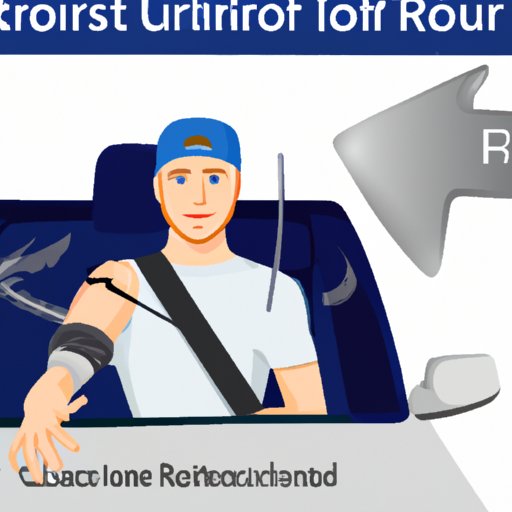
Introduction
Rotator cuff surgery is a common procedure that aims to repair damage to the muscles and tendons surrounding the shoulder joint. Recovering from this type of surgery can be a gradual process that requires patience, time, and a commitment to rehabilitation. For many patients, regaining the ability to drive is an important milestone on the road to recovery. Knowing when it’s safe to get behind the wheel is critical to ensuring a successful recovery without complications or setbacks.
Driving After Rotator Cuff Surgery: When is It Safe?
Before answering this question, it’s important to understand the recovery process and how it relates to driving. Immediately following surgery, patients may experience pain, stiffness, and limited mobility in the affected shoulder. These symptoms can persist for several weeks or months as the body heals and the shoulder regains strength and flexibility.
As a general rule, most patients can expect to resume driving four to six weeks after rotator cuff surgery. However, this timeline can vary depending on individual factors such as the severity of the injury, the extent of the surgery, and the patient’s overall health and fitness level. It’s important to consult with a doctor before getting behind the wheel to ensure that it’s safe to do so.
Preparing for Life Behind the Wheel: Tips for Driving After Rotator Cuff Surgery
There are several ways to prepare for driving after rotator cuff surgery. These include exercises and stretches to help improve range of motion and strength in the affected shoulder, as well as tips for adjusting your car’s seat and steering wheel for maximum comfort and safety.
Some popular exercises include pendulum swings, wall slides, and shoulder blade squeezes. These exercises can help increase blood flow to the affected area, reduce stiffness, and improve range of motion. It’s important to start slowly and gradually increase the intensity and duration of your exercises as your shoulder heals.
When it comes to adjusting your car’s seat and steering wheel, there are a few key things to keep in mind. First, make sure that your seat is positioned so that your feet can easily reach the pedals and your hands can comfortably grip the steering wheel. You may need to adjust the seat height, tilt, or lumbar support to achieve the best possible position.
In addition, consider investing in some modifications to your car that can make driving easier and more comfortable. Options include using a gel cushion on the seat for extra support, installing a spinner knob on the steering wheel for easier turning, or adding a panoramic rearview mirror to better monitor blind spots.
Navigating the Road to Recovery: Understanding the Risks of Driving After Rotator Cuff Surgery
While driving after rotator cuff surgery is generally safe for most patients, there are some potential risks that should be taken into consideration. These risks can include pain, stiffness, and reduced range of motion in the affected shoulder, as well as difficulty turning the steering wheel or gripping the gearshift.
To mitigate these risks, it’s important to take things slow and gradually increase your driving time and distance over several weeks or months. You may also want to avoid driving during peak traffic hours or on long road trips until you feel fully confident in your ability to handle the demands of the road. By staying mindful of these risks and taking a cautious approach to driving, you can help ensure a healthy and successful recovery.
When in Doubt, Talk to Your Doctor: The Importance of Seeking Medical Advice Before Driving After Rotator Cuff Surgery
Ultimately, the safest and most reliable way to determine when it’s safe to resume driving after rotator cuff surgery is to consult with a doctor. Your doctor can evaluate your specific condition, provide personalized advice and recommendations, and help you make an informed decision about when to get back behind the wheel.
In addition to providing medical guidance, your doctor can also help address any concerns or questions you may have about driving after surgery. Common concerns may include whether it’s safe to operate a vehicle while taking pain medication, how to handle emergency situations while driving with limited mobility, or how to best manage discomfort or pain while driving.
Reclaiming Your Independence: How to Regain the Ability to Drive After Rotator Cuff Surgery
For many patients, regaining the ability to drive after rotator cuff surgery is seen as a key step in regaining their independence and returning to their normal daily routine. While it can be a challenging and sometimes frustrating process, there are many success stories to draw inspiration from.
Some patients find that setting specific goals and tracking their progress can be helpful in staying motivated and focused during their recovery. Others may benefit from seeking out support groups or connecting with other patients who have gone through similar experiences. Whatever approach you choose, remember to take things slow, be patient, and always follow your doctor’s instructions and advice.
Final Thoughts
Recovering from rotator cuff surgery can be a long and sometimes difficult process, but with the right attitude, resources, and support, it’s possible to achieve a full and complete recovery. By taking a cautious and methodical approach to driving after surgery, patients can help ensure that they are able to safely and confidently return to the road and enjoy all the freedom and independence that comes with it.





